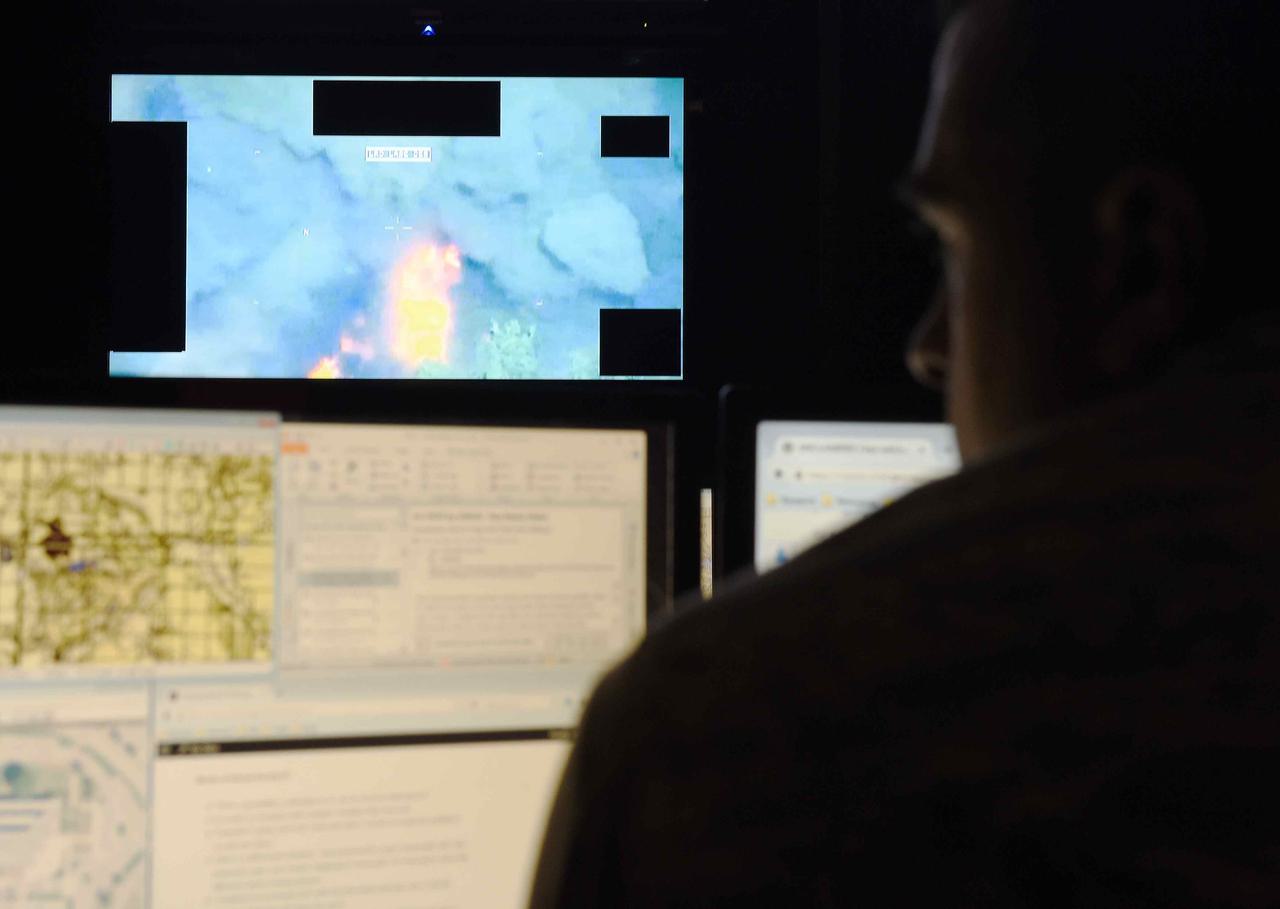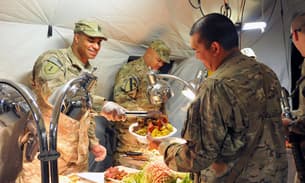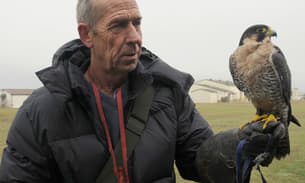
Reaping the rewards: How private sector is cashing in on Pentagon’s ‘insatiable demand’ for drone war intelligence
A US Air Force analyst with 11th Intelligence Squadron at Hurlburt Field reviewing drone data, June 2015 (US Air Force/Airman Kai White)
Some months ago, an imagery analyst was sitting in his curtained cubicle at Hurlburt Field airbase in Florida watching footage transmitted from a drone above one of the battlefields in the War on Terror. If he thought the images showed someone doing anything suspicious, or holding a weapon, he had to type it in to a chat channel seen by the pilots controlling the drone’s missiles.
Once an observation has been fed in to the chat, he later explained, it’s hard to revise it – it influences the whole mindset of the people with their hands on the triggers.
“As a screener anything you say is going to be interpreted in the most hostile way,” he said, speaking with the careful deliberation of someone used to their words carrying consequences.
He and the other imagery analysts in the airbase were working gruelling 12-hour shifts: even to take a bathroom break they had to persuade a colleague to step in and watch the computer screen for them. They couldn’t let their concentration or judgement lapse for a second. If a spade was misidentified as a weapon, an innocent man could get killed.
“The position I took is that every call I make is a gamble, and I’m betting their life,” he said. “That is a motivation to play as safely as I can, because I don’t want someone who wasn’t a bad guy to get killed.”
In spite of his vital role in military operations, the analyst wasn’t wearing a uniform. In fact, he wasn’t working for the Department of Defense, or indeed any branch of the US government.
He was working for one of a cluster of companies that have made money supplying imagery analysts to the US military’s war on terror.
When you mess up, people die – An intelligence contractor
The Bureau of Investigative Journalism’s award-winning drones team has spent six months exploring this intersection of corporate interests and global surveillance systems. Drawing on interviews with a dozen military insiders (including former generals, drone operators and imagery analysts), contracts obtained under the Freedom of Information Act, scores of contractor CVs publicly available on everyday job sites such as LinkedIn, and the analysis of millions of federal procurement records, the Bureau has identified ten private sector companies operating at the heart of the US’s surveillance and targeting networks.
HOW WE GOT THE DATA – CLICK HERE TO SEE OUR RESEARCH METHODS
The private sector’s involvement could grow: an Air Force official confirmed they are considering bringing in more contractors as it struggles to process the nearly half million hours of video footage filmed each year by drones and other aircraft.
Analysing this video can be a highly sensitive role. As one contractor analyst told the Bureau, “when you mess up, people die”.
While the military’s use of boots-on-the-ground contractors has prompted numerous congressional responses and tightened procurement protocol, among the general public few are even aware of the private sector’s role behind the scenes processing military surveillance video.
 “I think they’ve fallen under the radar to some degree,” said Laura Dickinson (pictured), a specialist in military contracting at George Washington University Law School and author of ‘Outsourcing War and Peace’. “It’s not that these contractors are necessarily doing a bad job, it’s that our legal system of oversight isn’t necessarily well equipped to deal with this fragmented workforce where you have contractors working alongside uniformed troops.”
“I think they’ve fallen under the radar to some degree,” said Laura Dickinson (pictured), a specialist in military contracting at George Washington University Law School and author of ‘Outsourcing War and Peace’. “It’s not that these contractors are necessarily doing a bad job, it’s that our legal system of oversight isn’t necessarily well equipped to deal with this fragmented workforce where you have contractors working alongside uniformed troops.”
In theory, these contractors aren’t decision-makers. Military officials and project managers are there to ensure they perform effectively, and according to the terms of their contracts.
But past experience in Iraq and Afghanistan suggests that management of military contractors does not always work perfectly in practice, especially when demand for the services they provide is surging.
As one commander told the Bureau, demand for Air Force intelligence against threats such as Islamic State is currently “insatiable”.
The ISR revolution
Intelligence, Surveillance and Reconnaissance, or ISR as it is known in military jargon, has become central to American warfare in recent years.

US counterterrorism operations such as the May 16 special forces raid on Islamic State commander Abu Sayyaf are critically dependent on the video captured by drones and other aircraft.
Analysts sitting thousands of miles away can tell a team on the ground the exact height of ladder they need to scale a building, or alert them to approaching militants. They can also establish a ‘pattern of life’, and what constitutes unusual movement in a particular place.
The aircraft are flown by pilots and operators from bases in the US, whilst the imagery analysts poring through the video they transmit are mostly housed in clusters of analysis centres – part of a warfighting structure spreading from Virginia to Germany known as the ‘Distributed Common Ground System’.
Remotely Piloted Aircraft, as the US military prefers to call drones, are more often associated with firing missiles at the tribal areas of Pakistan and Yemen than with gathering intelligence.
But it is their intelligence capabilities – particularly the ability to collect and transmit video footage in close to real time – that have revolutionised warfare.
“In Kosovo the intelligence we would get was typically a photo, normally black and white, often from a plane that took it the day before,” Lt Colonel David Haworth, director of combat operations at the US’s Combined Air Operations Center in Qatar told the Bureau.
“It’s like being able to talk on a can and a string before, and now I have a smartphone.”
The number of daily drone combat air patrols (CAPs) – that is, the ability to observe a particular spot for 24 hours – went up from five in 2004 to 65 in 2014 as demand for the intelligence they offered soared in Iraq and Afghanistan.
Colonel Jim Cluff, the commander of the drone squadrons at Nevada’s Creech Air Force Base, said the recent campaign against Islamic State has fuelled a new surge in demand.
“We’re seeing just an insatiable demand signal,” he said. “You cannot get enough ISR capability to meet all the warfighters’ needs.”
 Meeting this demand is not simply a question of having enough aircraft. By 2010, according to a presentation by David Deptula (pictured above), a now retired three star general who was asked to oversee the Air Force’s rapidly evolving ISR expansion in 2006, the average Predator or Reaper CAP required 10 pilots and 30 video analysts.
Meeting this demand is not simply a question of having enough aircraft. By 2010, according to a presentation by David Deptula (pictured above), a now retired three star general who was asked to oversee the Air Force’s rapidly evolving ISR expansion in 2006, the average Predator or Reaper CAP required 10 pilots and 30 video analysts.
“We’re drowning in data,” he told the Bureau.
‘Growth industry’
The military has always used the private sector to help operate its drone programmes; according to defence writer Richard Whittle, General Atomics, the manufacturer of the Predator, even supplied some of the pilots for the aircraft’s first sorties.
The defence industry’s supply of equipment to drone operations is well known, but the private sector’s role in providing a workforce has been harder to pin down. Through extensive research, the Bureau has traced the contracting histories of eight companies which have provided the Pentagon with imagery analysts in the past five years (the CIA’s transactions remain classified). Two more companies have been linked to the imagery analysis effort.

In 2007, defence industry behemoth SAIC – later rebranded Leidos – was contracted to provide services including imagery analysis to the Air Force Special Operations Command (Afsoc). A contracting document described SAIC’s involvement as “intelligence support to direct combat operations”. Its 202 contractors embedded in Afsoc were providing “direct support to targeting” among other functions (in military-speak, targeting can refer to surveillance of people and objects as well as lethal strikes).
In a bidding war to renew the deal in 2011, SAIC lost out to a smaller defence firm, MacAulay-Brown.
According to a copy of the contract obtained by the Bureau under a Freedom of Information Act request, MacAulay-Brown was tasked to “support targeting, information operations, deliberate and crisis action planning, and 24/7/365 operations.” The company asked for $60 million to perform these functions over three years.
Afsoc required MacAulay-Brown to provide a total of 187 analysts, some of whom were sourced through partnership with another company, Advanced Concepts Enterprises.
A portion of this work was to be carried out outside the US, according to the contract. The Bureau found two CVs posted online by people who had worked for MacAulay-Brown in Afghanistan. Both were embedded with special operations forces supporting targeting.
It’s like being able to talk on a can and a string before, and now I have a smartphone – Lt Col David Haworth
In January this year the latest award for Afsoc intelligence support went to another company, Zel Technologies. According to a document describing the scope of the contract, Zel was set to provide fewer overall analysts than MacAulay-Brown, but more imagery experts. Zel was also required to offer subject matter experts “in the areas of the Horn of Africa, Arabian Peninsula, Somalia, Syria, Iran, North Africa, Trans Sahel region, Levant region, Gulf States and territorial waters”. Afsoc has paid out $12 million for the first year, with options on the contract due to last until January 2018.
Although Zel Technologies is now the prime contractor, MacAulay-Brown is providing some of the intelligence specialists the contract demands. Indeed, it is not unusual for analysts to simply move from company to company as contracts for the same set of services change hands. They market themselves on recruitment sites with a surreal blend of corporate and military jargon.
One boasts of having supported the “kill / capture” of “High Value Targets”. Others go in to detail about their expertise in things like establishing a pattern of life and following vehicles.
The Air Force is not the only agency that employs contractor imagery analysts. Intrepid Solutions, a small business based in Reston, Virginia, received an intelligence support contract with the Army’s Intelligence and Security Command in 2012, scheduled to run until 2017.
In 2012 TransVoyant LLC, a leading player in real-time intelligence and analysis of big data based in Alexandria, Virginia, was awarded a contract with a maximum value set at $49 million to provide full motion video analysts for a US Marine Corps “exploitation cell” deployed in Afghanistan. Transvoyant had taken over this role from the huge Virginia-based defence company General Dynamics.
In 2010, the Army gave a million-dollar contract to a translation company, Worldwide Language Resources, to provide US forces in Afghanistan with “intelligence, surveillance and reconnaissance collection management and imagery analysis support”.
In the same year, the Special Operations Command awarded an imagery analyst services contract to the firm L-3 Communications, which was to net the company $155 million over five years.
Defence industry giants BAE Systems and NSA whistleblower Edward Snowden’s former employer Booz Allen Hamilton are also involved in the US’s ISR effort.
BAE Systems describes itself as “the leading provider of full-motion video analytic services to the intelligence community with more than 370 personnel working 24 hours a day”. The Bureau has traced some of the activities it carried out through social media profiles of company employees. People identifying themselves as video and imagery analysts for BAE state that they have used real-time and geo-spatial data to support tracking and targeting.
A job advert posted on June 10 by BAE gave further insight into the services provided. The posting sought a “Full Motion Video (FMV) Analyst providing direct intelligence support to Overseas Contingency Operations (OCO)” to be “part of a high ops tempo team, embedded in a multi-intelligence fusion watch floor environment”.
Booz Allen Hamilton has also aided the intelligence exploitation effort for special operations command at Hurlburt Field. Its role included “ongoing and expanding full motion video PED operational intelligence mission”, according to transaction records. A recent job ad shows the company is looking for video analysts to join its team “providing direct intelligence support to the Global War on Terror”.

The hundreds of millions of dollars paid to these companies for imagery analysis represent just a fraction of the private sector’s stake in America’s global surveillance effort. The Bureau has found billions of dollars of contracts for a range of ISR services. These include the provision of smaller drones, the supply and maintenance of data collection systems, and the communications infrastructure to fly the drones and connect their sensors with analysts across the other side of the world. These contracts have gone to companies including General Dynamics, Northrop Grumman, Ball Aerospace, Boeing, Textron and ITT Corporation.
General Deptula believes military demand for ISR will continue to grow. As he puts it, “Intelligence, Surveillance and Reconnaissance is a growth industry.”
Private eyes
In the Air Force at least, contractor imagery analysts are still in the minority of the work force. Around one in 10 of the people working in the processing, exploitation and dissemination (PED) of intelligence is estimated to be either a government civilian or a contractor. The Hurlburt Field analyst, who is here referred to as John (like other analysts interviewed, he didn’t want his real name to be published because of the sensitivity of the subject matter) estimates that they represent around an eighth of the analysts working there in support of Special Operations.
John argues that taking on even a small number of contractors helps ease the strain on the uniformed force without incurring the expense of pensioned, trained, health-insured employees.
In the military no-one’s obligated to respect your time – ‘John’, a contractor analyst
“Contractors are used to fill the gap to give enough manpower to provide flexibility necessary for military to do things like take leave,” he said.
Contractor imagery analysts are invariably ex-military, but the framework of their employment and their incentives are differently aligned once they join the private sector.
“In the military no-one’s obligated to respect your time,” explained John. “There were months you’d never get off days – If they need you to clean the bathroom on your off day that’s what you’ve got to do.”
“As a contractor you’re not as invested in the unit…your motivations are going to be more selfish.”
John and other analysts stressed however that contractors were highly professional, and able to provide a concentration of expertise.
“By the time an airman has built up enough experience to be competent at the job it’s usually time to change their duty location. Age also has a lot to do with the professionalism of contractors. Most contractors are at the youngest mid to late 20s, whereas Airmen are fresh out of high school,” said one analyst. “As an FMV (analyst), you cannot identify something unless you’ve seen it before.”
Screening for trouble
According to John the PED units at Hurlburt Field were much smaller than those of regular Air Force crews, consisting of only about three or four people.
As well as an analyst to watch the video in near real-time, and one to make the call on whether to type an observation in to the chat channel (often described as a ‘screener’), units typically also need a geospatial analyst to cross-reference the images brought up on the screen with other data.

Sitting there watching a video screen sounds simple, but the herculean amount of concentration involved requires real discipline and commitment. According to analysts interviewed, between 80 and 85% of the time is spent on long-term surveillance, when very little is happening. “You can go days and weeks watching people do nothing,” said John.
Another contractor interviewed said that because of the “long durations of monotonous and low activity levels”, a good analyst needs “attention to detail and a vested interest in the mission.”
“Many of the younger analysts view the job as a game,” he said. “It is critical to understand everything that happens, happens in real life. When you mess up, people die. In fact, the main role of the FMV analyst is to ensure that does not happen.”
The screeners type their observations in to a chat channel called mIRC, which is seen by the drone pilot and sensor operator, who are usually sitting in a different base. The Mission Coordinator, or Mission Intelligence Coordinator, typically sitting on the same base as the pilot and operator and communicating with them through a headset, helps ensure they don’t miss anything important in the mIRC.
Sometimes, John said, the analysts and the Mission Coordinator will communicate directly with each other in what is known as a “Whisper chat”.
“It gives you a way to say ‘this is what we think we saw’,” he explained, adding dryly, “a large part of the job is an exercise in trying not to kick the hornets’ nest.” According to John, once you’ve influenced the mentality of the pilot and operator by typing something which could signal hostility in to the chat, it’s hard to retract it.
He likens his role to that of a citizen tipping off armed police about criminals.
“As a civilian I don’t have authority to arrest someone, but if I call the police and say ‘this person’s doing something’, and say ‘I think that guy’s dangerous’…the police are going to turn up primed to respond to the threat, they’ll turn up trusting my statement,” he said. “It could be argued that I was responsible, but I’m not the one shooting.”
John said that in his unit, imagery analysts usually took a back seat once the use of force had been authorised.
A misidentification of an enemy combatant with a weapon and a female carrying a broom can have dire consequences – An unnamed intelligence contractor
Because there is usually a slight delay between the drone crew receiving the feed and the analysis crew seeing it, John said, “in a situation where it gets high-paced they (military personnel)’ll cut the screener out entirely”.
The other analyst however said that in his experience the PED unit still maintained its function for “identifying and confirming IMINT (imagery intelligence) lock on the target” once force is authorised. Video analysts, he said, had the capability to tell other crew members to abort a strike under some circumstances, and the analyst could receive “blowback” when things went wrong. The video analyst is the “subject matter expert,” he explained. “As such you have an important role in all the events that have led up to the determination for using force on the target. While you are not the one firing the missile, a misidentification of an enemy combatant with a weapon and a female carrying a broom can have dire consequences.”
Inherently governmental?
Given the Air Force’s efforts to keep contractors out of sensitive, decision-making positions, the contractors’ role in supporting targeting seems surprising, at first glance.
Charles Blanchard was the Air Force’s chief lawyer between 2009 and 2013 when he advised the officials spearheading these efforts.
He describes himself as a “purist” when it comes to contractors flying armed drones. But for a function like imagery analysis, his view is more flexible. “I’d be comfortable with some contractors sprinkled in to this framework because you have so many eyes on one target usually,” he said.
“I’d be uncomfortable with contractors advising the commander ‘here’s where the target is’, unless the data collected and analysed was so clear that the Commander could confirm this for themselves, as often happens.”
The constraints on using contractors are often more to do with command culture than the “mushy” legal framework surrounding inherently governmental functions, Blanchard explained.
“A commander in the military justice system has a lot more authority to take action where mistakes are made. Someone in blue uniform – or green or white – is someone they feel they have authority over.”
The consensus seems to be that contractors effectively taking targeting decisions is undesirable.
Someone in blue uniform – or green or white – is someone they feel they have authority over – Charles Blanchard
MacAulay-Brown’s contract with Afsoc stipulated that the contractors were not to be “placed in a position of command, supervision, administration of control” over military or civilian personnel.
There are concerns that such safeguards may be diluted in practice if contractor use goes up.
One of the analysts interviewed said that contractors were already relied on for their greater expertise and experience, effectively placing them in the chain of command.
“It will always be military bodies or civilian government bodies as the overall in charge of the missions…however you will have experienced contractors act as a ‘right-hand man’ many times because typically contractors are the ones with subject matter expertise, so the military/government leadership lean on those people to make better mission related decisions,” he said.
The profit motive
Although it is hard for the military to discipline contractors, people are keeping tabs on them and providing them with an incentive to do their jobs well.
John noted that the knowledge that “you can get fired” is a motivational factor for contractors.
In theory, the possibility of losing the contract should also incentivise the contractors’ bosses to field the best possible staff and manage them closely.
Jerome Traughber of the Eisenhower School for National Security and Resource Strategy is a former program manager for airborne reconnaissance acquisitions in the Air Force. He said that in his experience of intelligence support services, a company’s bid and performance would be scrutinised closely, with incentive fees built in.
“If a contractor wasn’t measuring up we’d make a change very quickly,” he said.
A large part of the monitoring is done through contracting officers, who liaise with other personnel inside the warfighting unit to evaluate the performance of the contractors embedded there.
Traughber acknowledged, however, that during the surge in Afghanistan, when thousands of contracts needed to be overseen, contracting officers and their counterparts inside military units were overwhelmed by their work load.
Nor is it clear that poor performance would necessarily prevent a company getting another contract. Daniel Gordon, a retired law professor and previous Administrator of Federal Procurement Policy, argues that the past performance criteria that contracting officers are supposed to take in to account when awarding bids might not always be rigorously assessed.
“As soon as you start saying the contractor didn’t do a good job you risk having litigation, lawyers are going to get involved, it’s just not worth it, so… everyone’s ok, no-one’s outstanding, which makes the rating system completely meaningless,” he said.
Another potential problem with the profit motive as a way of delivering good performance is that contractor pay has reportedly gone down.
Mary Blackwell, the president of Advanced Concepts Enterprises, one of the subcontractors who provided analysts in Hurlburt Field, said that since mandatory defence budget caps took effect in 2013, the value of contracts has decreased.
Imagery analysts, along with everyone else, have seen their pay cut by between 15 and 20%, she said.
“The military people – their pay is set. The only place where there’s any room is the contracts.”
This could drive down quality in the long term, contractors say. “It is running good analysts off,” said one. “The quality of force is suffering.”
The Bureau of Investigative Journalism contacted all of the contractors named in this story with a series of questions. None provided a statement, though several directed queries towards the US military. The Pentagon and the US Air Force were contacted for comment with a series of questions about transparency and oversight for contractors involved in ISR.
A spokeswoman for the Air Force said ISR was “vital to the national security of the United States and its allies”, and there was an “insatiable demand” for it from combatant commanders. She said this demand was the reason for increasing use of contractors, which she said was a “normal process within military operations”.
On the issue of whether private contractors’ assessments risk pre-empting the military’s official decisions, she said the service had thorough oversight and followed all appropriate rules.
“Current AF Judge Advocate rulings define the approved roles for contractors in the AF IRS’s processing, exploitation and dissemination capability,” she said.
“Air Force DCGS [Distributed Common Ground System] works closely with the Judge Advocate’s office to ensure a full, complete, and accurate understanding and implementation of those roles. Oversight is accomplished by Air Force active duty and civilian personnel in real time and on continual basis with personnel trained on the implementation of procedural checks and balances.
Transparency gap
There are tremendous pressures…oversight could easily break down – Laura Dickinson
Contractors such as John pride themselves on their professionalism and skill. But as ISR demand continues to rise, robust oversight is needed – in particular to ensure contractors do not creep into decision-making roles.
“There are tremendous pressures for that ratio of contractors to governmental personnel to swell,” she argued.
“If that ratio balloons, oversight could easily break down, and the current prohibition on contractors making targeting decisions could become meaningless.
Laura Dickinson argues the lack of information about drone operations makes such oversight much harder. “We urgently need more transparency,” she said.
The Department of Defense now publishes a quarterly report on the number of contractors in Iraq and Afghanistan, with a breakdown of their functions, but Dickinson said she was not aware of any such information being released on contractors in drone operations.
“There are tremendous pressures for that ratio of contractors to governmental personnel to swell,” she argued.
“If that ratio balloons, oversight could easily break down, and the current prohibition on contractors making targeting decisions could become meaningless.”
*A version of this story appeared in the Guardian.




